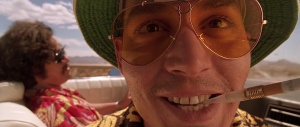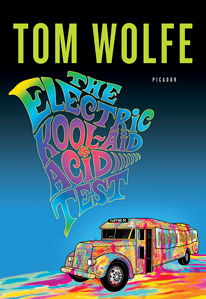I recently read two of the most prolific examples of Gonzo journalism in my Journalism 318: Literature of Journalism. With the recent addition of a Mass Communications minor to my degree audit, I added several Journalism classes to a course load already laden with writing heavy History and English classes. My initial reaction to the differences between journalism and literature was that one conveyed hard facts while the other created a story to relay a truth. Or better yet, an atmosphere. It never occurred to me that the two occasionally combine. But they do. And as I read Hunter S. Thompson’s Fear and Loathing in Las Vegas and Tom Wolfe’s The Electric Kool-Aid Acid Test, I became enthralled with Gonzo journalism at its finest.
 Gonzo journalism combines describing the action while simultaneously living it. Thompson did this in his acid-trip of all acid-trips to Las Vegas. He wrote in a first-person narrative in order to achieve an accurate representation of the scenario through personal experiences and emotions. Elements of literature enter journalism as a Gonzo journalist forsakes hard facts for the sake of conveying a particular interpretation of the situation to the reader. By using sarcasm, humor, and exaggeration, Thompson revealed a satirical journey he experienced into the heart of the American dream.
Gonzo journalism combines describing the action while simultaneously living it. Thompson did this in his acid-trip of all acid-trips to Las Vegas. He wrote in a first-person narrative in order to achieve an accurate representation of the scenario through personal experiences and emotions. Elements of literature enter journalism as a Gonzo journalist forsakes hard facts for the sake of conveying a particular interpretation of the situation to the reader. By using sarcasm, humor, and exaggeration, Thompson revealed a satirical journey he experienced into the heart of the American dream.
Tom Wolfe approaches Gonzo journalism in a slightly different fashion.  He maintains a first-person narrator throughout the story. He is physically next to Ken Kesey. But he stays outside the realm of immediate action. Wolfe dictates the journey of the Merry Pranksters and the kool-aid teaming Acid Graduations as an outsider. But his creative approach and prose saturated in Owsley acid make him a less reliable narrator. Similar to his friend and colleague Thompson, Wolfe wished to conjure a portrait of the Merry Pranksters by using elements of journalism and literature. And in a book that reeks of marijuana, Hell’s Angels, and LSD, he did just that.
He maintains a first-person narrator throughout the story. He is physically next to Ken Kesey. But he stays outside the realm of immediate action. Wolfe dictates the journey of the Merry Pranksters and the kool-aid teaming Acid Graduations as an outsider. But his creative approach and prose saturated in Owsley acid make him a less reliable narrator. Similar to his friend and colleague Thompson, Wolfe wished to conjure a portrait of the Merry Pranksters by using elements of journalism and literature. And in a book that reeks of marijuana, Hell’s Angels, and LSD, he did just that.
